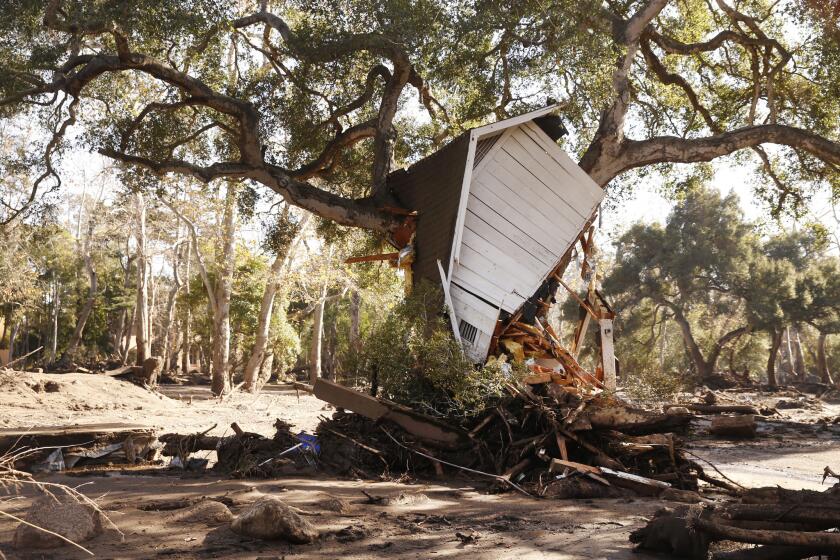Hughes fire scorches more than 10,000 acres near Castaic; thousands flee

- Share via
• Southern California expects less than half an inch of rain Saturday through Monday.
A new fire exploded Wednesday north of Castaic, charring more than 10,000 acres and forcing thousands to flee their homes amid a month of extreme fire conditions that have plagued Southern California.
The Hughes fire started off Lake Hughes Road just before 11 a.m. and quickly prompted evacuations orders in and around Castaic Lake, which by afternoon extended toward Ventura County to the west and near Sandberg to the north. More than 31,000 people were ordered to evacuate, and warnings were issued to 23,000 others.
The fire was initially reported at 50 acres but grew to 5,000 acres in the first two hours, fanned by strong Santa Ana winds, according to the California Department of Forestry and Fire Protection. By 5 p.m., fire officials said they were starting to get a handle on the fast-moving blaze.
“It was really the aircraft, in addition to all of those ground resources, which allowed us to get the upper hand,” said L.A. County Fire Chief Anthony Marrone at an evening news conference. “Had you been here a few hours ago, the situation looked much different, and it certainly looked much more aggressive.”
- Share via
Crews reached 14% containment on the 10,176-acre blaze shortly before 10 p.m.
A red flag warning will remain in place in areas of L.A. and Ventura counties until 10 a.m. Friday, as moderate Santa Ana winds sweep through the region and continue to challenge firefighting efforts, according to the National Weather Service.
Amid the rapid spread of the fire, a stretch of Interstate 5 was closed for several hours, snarling traffic. It reopened in both directions around 6 p.m., while the offramps at Lake Hughes Road and Parker Road remained closed, according to the California Highway Patrol.
Air quality was in the unhealthy range in the area of the Hughes fire, according to the Ventura County Air Pollution Control District. An alert was issued Wednesday afternoon for Camarillo, Fillmore, Moorpark, Oxnard, Piru, Santa Paula, Simi Valley and Ventura.
A smoke advisory was also issued for a wide swath of northwestern L.A. County from the Santa Monica and Malibu coastline to the south up through the San Fernando Valley, Santa Clarita and into the Castaic Lake area.
More than 4,000 firefighting personnel are assigned to the incident, and so far there have been no reports of structures damaged, Marrone said.
Moments after the Hughes fire exploded, L.A. County Deputy Dist. Atty. Jonathan Hatami said he raced out of the Michael Antonovich Antelope Valley Courthouse in Lancaster and drove back to Santa Clarita, where hundreds of kids were being evacuated from West Creek Academy as the sky overhead darkened with smoke.
“You had some parents crying. You had younger kids ... they were crying. You could see the smoke from the school. Everybody is kind of on edge,” said Hatami, whose children are 8 and 10.
The veteran prosecutor, whose wife is a Los Angeles County sheriff’s deputy who had been dispatched to help with evacuations, said his entire family was experiencing “fire fatigue” after more than two weeks spent waiting for wind-driven flames to threaten their home.
“It’s a lot. I love California. I love Los Angeles, but this is definitely stressful,” he said. “It’s hard to go to work when you’re worried your house could burn down and your kids are at school, and your wife is out there, and you don’t know what’s going to happen with her.”
The fire was burning about five miles north of the county’s Castaic jail complex, forcing deputies to move 476 inmates from the tent-like barracks at Pitchess Detention Center to the concrete North County Correction Facility. Both buildings are part of the same jail complex that is within an evacuation zone.
At 4:30 p.m., Sheriff Robert Luna said the department had plans in place to fully evacuate the jail complex if fire officials deemed it necessary. But, based on the advice of fire officials, Luna said the current plan was to continue sheltering in place.
Though roughly three-quarters of the department’s inmate transport buses are not in operation, Luna told The Times that Ventura County was sending buses, and the department may also use Metro buses, with extra deputies to provide security.
Meanwhile, as the sun began to set over Castaic Lake on Wednesday, the hills to the north and east were engulfed in flame, casting an eerie orange glow across the valley below.
On Lake Hughes Road, wooden piles supporting power lines had burned and snapped, spreading high-voltage wires like snakes across the pavement. Overhead, a pair of firefighting helicopters circled in constant, hurried laps between the lake and the burning hillsides.
Across Ridge Route Road, where a string of apartment buildings stood a stone’s throw from the flames, residents watched the spectacle like fans at a sporting event — phones held aloft, sharing the shocking images with friends and family via livestream video.
Antonio Morataya had been at work about 15 minutes away when he heard the field next to his apartment building was burning. He raced home, tossed his passport and whatever other documents he could grab into his car, and then stepped outside to watch what turned into an hours-long battle between firefighters and the flames.
As the fire raged, Lake Hills Community Church Pastor David Cummings coordinated with his congregants over the phone, helping them find lodging and praying with them as they left their homes. Of the 140 church members who attend the church, about half live in the area where evacuations have been issued, he said.
“We’re keeping in touch with them and people are going over to help them get their needed goods,” Cummings said from his home in Valencia. “We’re providing homes to the other half of congregation. Some are going to their families, but we’re making sure they have a place to stay and all their needs are being met.”
Elsewhere, Castaic Union School District principals who were at a training meeting when the Hughes fire broke out were told to immediately return to their schools.
Northlake Hills Elementary received an evacuation order while the principals returned to their schools and assisted parents and guardians who arrived to pick up their children. Students from Castaic Middle School and Castaic Elementary School were evacuated to a Ralphs parking lot at Hasley Canyon to wait for their parents, according to the California Highway Patrol.
As many as eight helicopters were dropping water on the fire to slow the spread of the flames. Strike teams were also mobilizing to protect homes in the path of the fire. Cal Fire has deployed 20 prepositioned engines, four hand crews, four bulldozers and aircraft to support the response to the Hughes fire, according to the agency.
But strong winds in the area proved to be a challenge for firefighters. Wind gusts reached 31 mph Wednesday afternoon in Castaic and were expected to increase over the next several hours, said Ariel Cohen, a meteorologist with the National Weather Service in Oxnard.
Forecasts show that gusts could reach up to 40 mph in the evening and even higher overnight, according to the weather service.
It is not clear what sparked the fire. The blaze is burning in the same area that was charred in the Route fire in 2022. That blaze, which ignited during a heat wave in late August, burned 5,200 acres and forced evacuations in Castaic.
The Hughes fire was one of two that began Wednesday amid persistent red flag conditions in the region.
In San Diego County, a fire broke out near Rancho Bernardo and grew to roughly four acres, briefly triggering evacuations before its forward progress was stopped.
A storm expected to arrive this weekend is forecast to bring some moisture to Southern California’s parched landscape. But forecasters have warned it will not end the fire season.
This article is provided free of charge to help keep our community safe and supported during these devastating fires.
Because the rain is expected to be light, the risk of debris flows in burned areas is low. There’s a chance a thunderstorm could emerge directly over a recently burned area — creating a risk of landslides — but it’s not likely, said Ryan Kittell, a meteorologist with the National Weather Service.
Still, Los Angeles city and county officials have started preparing for the rain. Public works in the coming days will install barriers, remove debris and divert runoff from the stormwater system into the sewer system, where it can be treated. Crews are also clearing drains and roadways, placing sandbags to shore up vulnerable infrastructure and preparing debris basins for the incoming storm, officials said Wednesday.
The Palisades fire, which ignited more than two weeks ago, leveled a huge swath of Pacific Palisades, burning more than 23,400 acres and destroying at least 6,662 structures, according to Cal Fire. The blaze was 70% contained as of Wednesday evening.
The Eaton fire, which charred a devastating path through the Altadena and Pasadena areas, destroying 9,418 structures, was 95% contained as of Wednesday night.
Authorities have confirmed 28 deaths, 11 in the Palisades fire and 17 in the Eaton fire.
We’re tracking damage assessments from the Eaton and Palisades fires, which destroyed 12,000 structures in Altadena and Pacific Palisades.
For recently burned areas, Kittell said, the rain could serve as a practice run in preparing for risks that are likely to remain for the next year or two, after which the risk of debris flows and other landslide risks is substantially lowered.
Rainfall rates need to be at around half an inch per hour or more to start causing debris flows of significance, Kittell said. Rates that are lower — like a quarter of an inch per hour — are less significant, causing “maybe some muddy water moving over some roads,” he said.
Although meteorologists say the risk of debris flows in the burn areas is low, it’s also very unlikely the rain will snuff out the fire season.
“If we get one more little dry spell, it’ll pretty much negate any benefit from this rain,” Kittell said.
That dry spell may be just around the corner. The longer-term outlook suggests that, on the heels of this storm, there could be more weeks of dry weather going into early February.
A Thanksgiving Day storm hit Southern California, bringing heavy rain that could result in mudflows in recent wildfire burn areas.
Residents whose homes back up to charred hillsides can request the county assess their property and the condition of the slope and advise whether any mitigation needs to be done, said Mark Pestrella, the Los Angeles County Public Works director.
He emphasized that Angelenos in burn-scarred areas should use caution during upcoming rain events.
“Let me be clear, if you live in an area and you’re in the home, and there is a slope behind your home that is burned, and it’s maybe 20 feet or more in height, and it is adjacent to the property in any direction, your best bet is not to be in that home when it rains,” Pestrella said.
Times staff writers James Queally, Richard Winton, Kevin Baxter and Stacy Perman contributed to this report.
As firefighters continue to battle multiple major wildfires, The Times has compiled a list of resources to help.
More to Read
Sign up for Essential California
The most important California stories and recommendations in your inbox every morning.
You may occasionally receive promotional content from the Los Angeles Times.






















